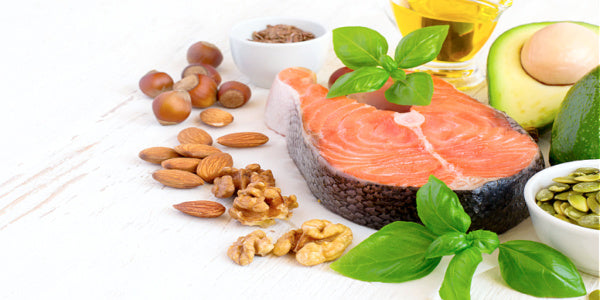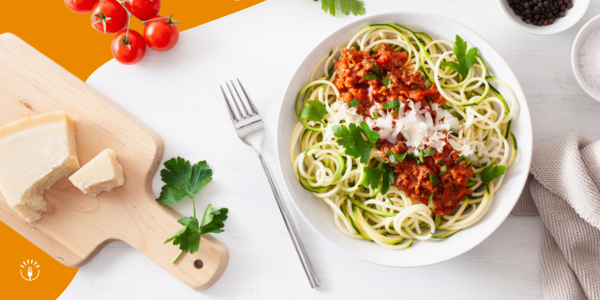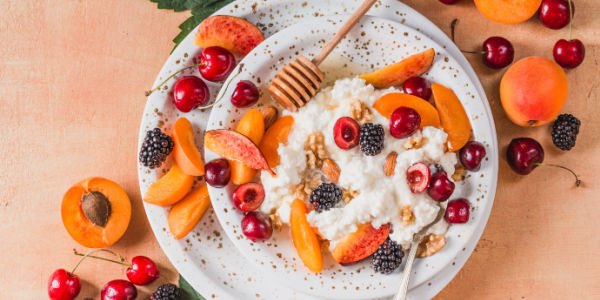
High cholesterol is a major health concern relative to its contribution to heart disease. However, cholesterol is actually an integral and healthy component of normal body processes.
Without cholesterol, important hormones would not be produced, vitamin D maintenance could be compromised, and the absorption of fat would be reduced.
But to benefit overall health, there needs to be a right balance of cholesterol, particularly having high levels of that "good" HDL cholesterol.
Wondering how to raise HDL with diet? Discover which foods you should eat more of to increase HDL cholesterol to a healthy range.
10 Foods to Increase HDL Cholesterol
If you find out from blood work your HDL cholesterol is too low, the good news is there are many ways to increase your good cholesterol. Specifically, tweaking some diet changes can positively affect both LDL and HDL cholesterol.
It can be confusing to know what to eat to improve blood cholesterol, as there are common myths about cholesterol, like the confusion on eggs. If wondering what foods to focus on for getting up your HDL, focus on the following research-backed, top foods to raise HDL cholesterol.
1. Avocados
Whereas most fruits are rich in natural sugar, avocados are predominately high in monounsaturated fat which makes them a top HDL cholesterol food.
A 2018 review on avocado consumption and heart disease concluded avocado intake increases HDL cholesterol. Avocado intake did not significantly affect total or LDL “bad” cholesterol, but avocados played an important role in helping raise HDL.
Avocado is versatile in the kitchen and can be enjoyed as a snack, spread onto a whole grain slice of toast, blended into smoothies, topped onto salads, mixed into dressings, baked into muffins, and creamed into ice creams and mousses.
2. Fatty Fish
Anchovy, tuna, herring, rainbow trout, halibut, and other fatty fish are natural sources of omega-3 fatty acids. Omega-3s are a type of polyunsaturated fat shown to lower inflammation in the body and protect from heart disease.
And when compared to omega-3 supplementation, a 2017 study concluded the consumption of fresh fish may be superior in positively modifying the lipid profiles, increasing HDL included.
The American Heart Association (AHA) recommends the general population consume at least two servings of fish, particularly fatty fish, each week. However, the FDA warns children and pregnant women to avoid fish high in mercury contamination (including shark, swordfish, king mackerel, or tilefish). Instead, eat a variety of low-mercury fish and shellfish - such as canned light tuna, salmon, pollock, and catfish - up to 12 ounces per week.
Check local advisories about the utmost safety of fish. A healthcare provider can also help direct recommendations regarding safe fish intake.
3. Flaxseeds
Flaxseeds are a plant-based source of omega fatty acids, which offers many benefits for those limiting or avoiding fatty fish for whatever reason.
Beyond improving HDL, flaxseeds offer many health benefits thanks to the fiber, B vitamins, and other valuable vitamins and minerals they supply. Include ground flaxseed in the diet by adding a tablespoon to breakfast cereals, yogurts, muffins, and breads.
4. Olive Oil
Unlike butter, margarine, and coconut oil, olive oil is rich in mono and polyunsaturated fatty acids. These types of fats can offer heart-healthy benefits.
In fact, a 2019 review found increasing consumption of virgin olive oil (along with nuts, seeds, whole grains, and fish) was associated with improvements in HDL.
5. Peanuts and Peanut Butter
Peanuts are a rich source of monounsaturated fat, and a 2007 study found eating peanuts increased HDL levels without increasing other cholesterol values.
Peanut butter can also provide the same HDL benefits as peanuts. When choosing a nut butter, do not let "natural" and "organic" fool you into thinking the product is “healthy.” Such products tend to be filled with added oils, sugar, and salt.
To avoid unnecessary additives, utilize the ingredients label and stay clear of words like "palm oil" and "corn syrup." The ingredients on a peanut butter jar should feature peanuts and maybe a little added salt.
6. Nuts and Nut Butter
Nuts are valuable sources of healthy fats, along with supplying fiber and plant sterols shown to block the absorption of cholesterol.
Almonds, walnuts, cashews, pistachios, and brazil nuts are good foods for cholesterol management.
However, while nuts are chockfull of beneficial nutrients, they are calorically dense. To keep fat and calorie content in check, opt for an ounce (about ¼ cup or palmful) of nuts daily.
As with peanut butter, nut butters can also provide HDL benefit. Nut butters should also have minimal ingredients on the label with just nuts and maybe a little added salt.
7. High-Fiber Fruits and Veggies
A 2015 study found a relationship between increased dietary fiber intakes and increases of HDL cholesterol. Specifically, the study found when fiber intake increased from less than 18 g/day to over 30 g/day, the average HDL cholesterol level increased by 10 percent.
Increasing fruits and vegetables is a way to get more fiber in the diet to help raise HDL levels. Veggies are naturally low in calories and high in fiber, especially when choosing leafy greens, broccoli, cauliflower, celery, and other non-starchy options. Aim for at least three servings per day.
Fruits rich in fiber such as berries, pears, apples, and citrus can also help contribute to bumping up fiber intake as well as providing many other nutrients.
Another way to boost HDL health is to eat more dates. Dates provide protection specifically to HDL from oxidative damage, according to a 2009 study. This protection could help play a role in reducing the risk for cardiovascular disease.
8. Soy
While there has been some question about if soy is healthy, soy is an excellent meat substitute to lower fat intake while granting plant-based protein. In fact, a 2003 review on heart health benefits of soy found soy products are beneficial in improving cholesterol levels, including increasing HDL cholesterol.
When choosing soy-based foods, opt for more wholesome options including tofu, tempeh, and edamame, rather than veggie burgers, nuggets, and other texturized soy products.
9. Oats
Oats contain a fiber component known as beta-glucan, which is a form of soluble fiber. A 2007 study concluded that 6 grams of beta-glucan from oats not only increases HDL levels but reduces total cholesterol and weight.
In addition to oats, barley, wheat, and other whole grains can help improve total cholesterol levels due to their high fiber, antioxidant, vitamin, and mineral amounts. Aim for three to five servings of whole grains daily.
10. Red Wine
One 2005 study found moderate red wine consumption was associated with increasing HDL. Another 2005 study found moderate red wine consumption for 4 weeks to be associated with desirable changes in HDL. Interestingly, water with grape extract did not have to same beneficial effects.
More is not better with red wine; it is important to stress moderate amount of red wine. Too much alcohol can lead to detrimental health effects including cholesterol.
Men should limit alcohol consumption to two servings per day while women should limit to one serving. Servings include 12 ounces of regular or light beer, 5 ounces of red or white wine, and 1 and a half ounces of liquor.
In Summary: How to Raise HDL with Diet
Diet is one way to significantly impact your cholesterol levels which includes raising the good HDL. To start, focus on foods that provide healthy fats including avocados, flaxseeds, olive oil, fatty fish, peanuts, and nuts to help raise HDL.
Additionally, foods high in fiber like fruits, vegetables, soy, oats, and other whole grains can also increase HDL. Research has also shown in moderation red wine can positively affect HDL.
In conclusion, no single food is solely responsible for shifting cholesterol. It is a combination of eating choices and consistent habits along with other healthy lifestyle factors such as exercise.
References:
Avellone G, Di Garbo V, Campisi D, et al. Effects of moderate Sicilian red wine consumption on inflammatory biomarkers of atherosclerosis. Eur J Clin Nutr. 60, 41–47 (2006). https://doi.org/10.1038/sj.ejcn.1602265.
Emekli-Alturfan E, Kasikci E, Yarat A. Peanuts improve blood glutathione, HDL-cholesterol level and change tissue factor activity in rats fed a high-cholesterol diet. Eur J Nutr. 2007 Dec;46(8):476-82. doi: 10.1007/s00394-007-0688-1. Epub 2007 Nov 7. PMID: 17989913.
Fish and omega-3 fatty acids. www.heart.org. Published November 1, 2021. https://www.heart.org/en/healthy-living/healthy-eating/eat-smart/fats/fish-and-omega-3-fatty-acids.
Hansen AS, Marckmann P, Dragsted LO, Finné Nielsen IL, Nielsen SE, Grønbaek M. Effect of red wine and red grape extract on blood lipids, haemostatic factors, and other risk factors for cardiovascular disease. Eur J Clin Nutr. 2005 Mar;59(3):449-55. doi: 10.1038/sj.ejcn.1602107. PMID: 15674304.
Hollænder PL, Ross AB, Kristensen M. Whole-grain and blood lipid changes in apparently healthy adults: a systematic review and meta-analysis of randomized controlled studies. Am J Clin Nutr. 2015 Sep;102(3):556-72. doi: 10.3945/ajcn.115.109165. Epub 2015 Aug 12. PMID: 26269373.
Reyna-Villasmil N, Bermúdez-Pirela V, Mengual-Moreno E, Arias N, Cano-Ponce C, Leal-Gonzalez E, Souki A, Inglett GE, Israili ZH, Hernández-Hernández R, Valasco M, Arraiz N. Oat-derived beta-glucan significantly improves HDLC and diminishes LDLC and non-HDL cholesterol in overweight individuals with mild hypercholesterolemia. Am J Ther. 2007 Mar-Apr;14(2):203-12. doi: 10.1097/01.pap.0000249917.96509.e7. PMID: 17414591.
Rock W, Rosenblat M, Borochov-Neori H, Volkova N, Judeinstein S, Elias M, Aviram M. Effects of date ( Phoenix dactylifera L., Medjool or Hallawi Variety) consumption by healthy subjects on serum glucose and lipid levels and on serum oxidative status: a pilot study. J Agric Food Chem. 2009 Sep 9;57(17):8010-7. doi: 10.1021/jf901559a. PMID: 19681613.
Zhou Q, Wu J, Tang J, Wang JJ, Lu CH, Wang PX. Beneficial Effect of Higher Dietary Fiber Intake on Plasma HDL-C and TC/HDL-C Ratio among Chinese Rural-to-Urban Migrant Workers. Int J Environ Res Public Health. 2015;12(5):4726-4738. Published 2015 Apr 29. doi:10.3390/ijerph120504726







